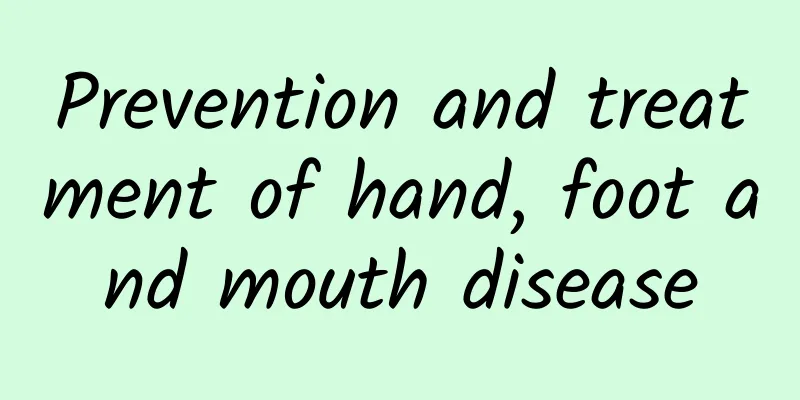Prevention and treatment of hand, foot and mouth disease

|
Prevention and treatment of hand, foot and mouth disease 1. Pathogen and epidemiology Hand, foot and mouth disease (HFMD) is an infectious disease caused by enterovirus. There are more than 20 types of enterovirus that cause HFMD. Among them, Coxsackievirus A16 (CoxA16) and enterovirus 71 (EV-71) are the most common. EV-71 is highly infective to the central nervous system. HFMD can occur in all seasons, with the highest incidence in summer and autumn. People are generally susceptible to it, and it is more common in children, especially those under 3 years old. Humans are the only known host of human enterovirus. It is mainly transmitted through the digestive tract, respiratory tract, contact with the patient's respiratory secretions, herpes fluid and contaminated objects. A few days before the onset of the disease, the virus can be detected in the pharyngeal secretions and feces of the infected person, and the virus can be excreted in the feces for up to 3-5 weeks. It is most contagious within 1 week after the onset of the disease. Both patients and latently infected people are sources of infection. The incubation period is 2-7 days, and the onset is often acute. Common symptoms include fever, pharyngeal discomfort, loss of appetite, and non-specific infection symptoms such as runny nose, cough, nausea, vomiting, and headache. The skin diagnosis is first maculopapular, and then turns into herpes. There is a small amount of fluid in the blisters. The rash is round or quasi-circular, about 3-7mm in size. The rash is centrifugal, mainly located in the mouth, hands, feet, and buttocks. Patients should be isolated for at least 2 weeks, and close contacts should be quarantined for at least 10 days. After infection, people can produce specific antibodies and gain immunity, but there is no cross-immunity between different types of viruses. 2. Clinical manifestations 1. Common cases Generally, the symptoms are mild, and the process is self-limited for those without complications. Most patients recover within a week, and the prognosis is good. Only intensive care and symptomatic treatment are needed. 2. Severe cases In a few cases, the disease progresses rapidly, and serious or even fatal complications such as brain, lung, and heart may appear within 1-5 days of onset, which must be taken seriously clinically. (1) Symptoms and signs of the nervous system may occur due to complications of meningitis, encephalitis, and encephalomyelitis. (2) Respiratory symptoms and signs occur due to concurrent pulmonary edema. (3) Symptoms and signs of the circulatory system due to concurrent circulatory disorders. 3. Laboratory Examination Depending on the specific conditions of the patient's condition, relevant examinations such as routine blood tests, blood biochemistry, blood gas analysis, cerebrospinal fluid, etiology, serology, chest X-ray, and magnetic resonance imaging can be performed selectively. 4. Diagnosis and differential diagnosis The diagnosis is not difficult based on the epidemiological history, age of onset, site of skin examination and laboratory tests. In addition to differential diagnosis from varicella, clinically, it is also necessary to make differential diagnosis from the following diseases: 1. Other rash diseases. 2. Encephalitis or meningitis caused by other viruses. 3. Pneumonia. 4. Fulminant myocarditis, etc. 5. Treatment (must be carried out under the guidance of a professional doctor). 1. Common cases There is no effective antiviral drug or specific treatment method at present, and the treatment is mainly symptomatic. Pay attention to isolation to avoid cross infection. Strengthen care, eat a light diet, and get adequate rest. 2. Severe cases Symptomatic treatment should be given according to the actual situation of the patient, and glucocorticoids and immunoglobulins should be used as appropriate. 6. Prevention 1. Patients must be isolated for treatment to avoid cross infection for at least 2 weeks. The patient's secretions, excretions, and items that have been in contact with the patient must be disinfected. Confirmed cases must fill out the infectious disease report card and report it immediately according to regulations. 2. Close contacts must be quarantined for at least 10 days and receive passive immunization through intramuscular injection of immunoglobulin. 3. Carry out scientific education for the general public to increase awareness of disease prevention and reduce the chance of illness. During the epidemic, do not go to public places where people gather, wear masks, pay attention to personal and environmental hygiene, ventilate the home frequently, dry clothes and quilts frequently, wash hands frequently, strengthen food hygiene, and do not eat (drink) raw or cold food. 4. Strengthen nutrition and physical exercise. 5. Nursery institutions and schools should strengthen morning inspections and isolate and treat suspected patients in a timely manner. Strictly control the return of sick children to schools and kindergartens. Isolation treatment should not be less than 2 weeks. |
<<: What to eat when you are sick? This most frequently asked question has an answer today!
>>: Don't let the disease take away your memory! Learn about these facts about Alzheimer's disease
Recommend
Risks of bilateral salpingectomy
As the connection between the uterus, ovaries and...
Why do girls bleed but it's not menstruation?
Bleeding from the vagina during menstruation is a...
How to treat hydrosalpinx by B-ultrasound
Hydrosalpinx is a gynecological problem that many...
Symptoms of female sex hormone disorders
In fact, women are most likely to encounter sex h...
Why does the urethra itch during late pregnancy?
It is very common for women to have itching at th...
How many days do I need to take anti-inflammatory drugs for medical abortion?
Women need to have artificial abortion or medical...
Do uterine fibroids cause pain?
Uterine fibroids are one of the most common gynec...
Reasons why vaginal discharge suddenly turns brown
If your leucorrhea suddenly turns brown, it usual...
Purple spots on your body? It's not an allergy!
Doctor, my son Zhuangzhuang has recently develope...
What should you do if you are injured by an animal? Choose different vaccines for different situations
"Do I need to get a rabies vaccine if I'...
How much is a cup of Heytea Zhizhi Qinlan fresh milk tea? Is Heytea Zhizhi Qinlan fresh milk tea delicious? How does it taste?
We all know that Heytea launches new flavors of d...
Is it okay to apply mineral water on the face? What should I pay attention to when applying saline on the face?
If the body absorbs minerals well, applying miner...
How to treat dysmenorrhea in children
Many girls have the problem of dysmenorrhea when ...
Which sanitary napkin is good?
Sanitary napkins are also called sanitary napkins...
There are three reasons for abdominal effusion in women
Under normal circumstances, there is a small amou...









